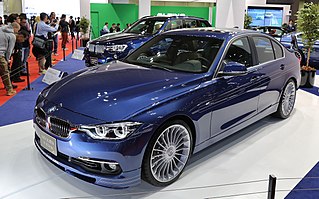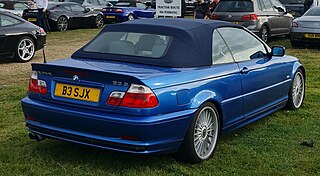
The Bentley Arnage is a full-size high performance luxury car manufactured by Bentley Motors in Crewe, England, from 1998 to 2009. The Arnage and its Rolls-Royce-branded sibling, the Silver Seraph, were introduced in the spring of 1998. They were the first entirely new designs for the two marques since 1980.

The Bugatti EB 110 is a mid-engine sports car produced by Bugatti Automobili S.p.A. from 1991 until 1995, when the company was liquidated. A small number of post-production cars were completed afterwards, with the last one built by Dauer in 2002 and another unfinished example completed in 2019. It was the only production model made by Romano Artioli's Italian incarnation of Bugatti.

The BMW M6 is a high-performance version of the 6 Series marketed under the BMW M sub-brand from 1983 to 2018.

Alpina Burkard Bovensiepen GmbH & Co. KG is an automobile manufacturing company based in Buchloe, in the Ostallgäu district of Bavaria, Germany that develops and sells high-performance versions of BMW cars. Alpina works closely with BMW and their processes are integrated into BMW's production lines, and is recognized by the German Ministry of Transport as an automobile manufacturer, in contrast to other performance specialists, which are aftermarket tuners. The Alpina B7 is produced at the same assembly line in Dingolfing, Germany, as BMW's own 7 Series. The B7's twin-turbo 4.4-litre V8 is assembled by hand at Alpina's facility in Buchloe, Germany, before being shipped to BMW for installation, and the assembled vehicle is then sent back to Alpina for finishing touches.

The BMW M2 is a high-performance version of the BMW 2 Series automobile developed by BMW's motorsport division, BMW M GmbH.

The BMW E31 is the first generation of the BMW 8 Series. It is a grand tourer built by BMW from 1990 to 1999 as a 2-door coupé, powered by either a V8 or V12 engine. Whilst it did supplant the original E24 based 6 Series in 1990, it was not a direct successor, but a new model class with a substantially higher price and performance than the 6 Series.

The Alpina B10 Bi-Turbo is a high performance version of the BMW 5 Series E34 executive car manufactured by German automobile manufacturer Alpina. Beginning production in 1989, the B10 Bi-Turbo was based on the 535i and received several upgrades by Alpina, being the fastest production sedan in the world at the time of its introduction. Production ended in 1994 with 507 examples produced.

The Alpina B4 and Alpina D4 are high-performance compact executive cars manufactured by the German automobile manufacturer, Alpina. Based on the BMW 4 Series, the B4 and D4 are manufactured in coupé and convertible body styles. The first generation B4 and D4 were launched in 2014 and the more powerful B4 S was launched in 2017.

The Alpina B3 (F30/F31) and Alpina D3 (F30/F31) are high performance compact executive cars manufactured by German automobile manufacturer, Alpina. Based on the BMW 3 Series (F30), the B3 is available in saloon and wagon body styles. The car was officially launched at the 2013 Geneva Motor Show.

The Alpina B3 (E90) and Alpina D3 (E90) are a series of high performance compact executive cars manufactured by German automobile manufacturer Alpina from 2007 to 2013. Based on the BMW 3 Series (E90), the B3 and D3 were available in coupé, saloon, convertible and station wagon body styles. The B3 was officially unveiled at the 2007 Geneva Motor Show.

The Alpina B6 (E63) is the second generation of the high performance grand tourer manufactured by German automobile manufacturer Alpina from 2005 to 2010. Based on the BMW 6 Series (E63), the car was available in coupé and convertible bodystyles. The B6 was introduced in 2005.

The Alpina B6 (F12) is the third generation of the high performance grand tourer manufactured by German automobile manufacturer Alpina. Introduced at the 2011 Tokyo Motor Show, the B6 was based on the BMW 6 Series and was available in coupé and convertible body styles, with the latter being introduced at the 2011 Frankfurt Motor Show. A third saloon bodystyle called the gran coupé was introduced in 2014. The Alpina B6 gran coupé was replaced by the Alpina B8 gran coupe (G16) in 2021.

The Alpina B7 (E65) is the third generation of the high-performance BMW 7 Series manufactured by Alpina from 2004 to 2008. Based on the BMW 7 Series (E65), the B7 was officially introduced to the public at the 2003 Frankfurt Motor Show. The B7 was the first Alpina to use a supercharged engine and was available in normal and long-wheelbase versions.

The Alpina Roadster S is a sports car manufactured by the German automobile manufacturer Alpina from 2003 to 2007. Based on the BMW Z4 (E85), the Roadster S was unveiled at the 2003 Frankfurt Motor Show.

The Alpina B7 (F01) is the fourth generation of the high-performance BMW 7 Series manufactured by Alpina from 2011 until 2015. Based on the BMW 7 Series (F01), the car was introduced to the public at the 2010 Chicago Auto Show and was available in normal and long-wheelbase versions, with xDrive or rear-wheel drive. The B7's engine was hand-built at the Alpina factory at Buchloe and then sent to the BMW factory in Dingolfing to be put into the body shell. The car was painted and initially assembled at the Dingolfing plant and was then sent back to Alpina for final assembly. It was the second Alpina B7 to be offered in North America, with 1,740 examples imported and sold in the United States.

The Alpina B7 Bi-Turbo, or Alpina B7, is the fifth generation of the high performance full-size luxury car manufactured by German automobile manufacturer Alpina. Based on the BMW 7 Series (G12), the B7 Bi-Turbo was introduced at the 2016 Geneva Motor Show. Known as the B7 in North America, the car is the third B7 model to be imported to the United States. The Alpina B7 is now history and, at least for now, there's no direct replacement planned. At the end the Alpina B7 has been discontinued in September 2022.

The Alpina B5 (E60) is the first generation of the Alpina B5 high performance executive car manufactured by German automobile manufacturer Alpina from 2005 to 2011. Based on the BMW 5 Series (E60), the car was available in saloon and wagon bodystyles. The car succeeds the Alpina B10.

The Alpina B5 and D5 (F10) are a series of high performance executive cars manufactured by German automobile manufacturer Alpina from 2011 to 2016. Introduced at the 2010 Goodwood Festival of Speed, the car is the second generation of the B5 and succeeds the B5 (E60). Based on the BMW 5 Series (F10), the car was available in saloon and wagon bodystyles.

The Alpina B5 and D5 (G30) are a series of high performance executive cars manufactured by German Automobile manufacturer Alpina. Introduced at the 2017 Geneva Motor Show, the car is the third generation of the B5 and succeeds the Alpina B5 (F10). Based on the BMW 5 Series (G30), the car is available in both saloon and wagon bodystyles.

The Alpina B3 S is a series of high performance compact executive cars manufactured by German automobile manufacturer Alpina from 2002 to 2006 based on the Alpina B3 developed from the BMW 3 Series (E46). The B3 S was available in coupé, saloon, convertible and station wagon body styles. The B3 S was introduced at the 2002 Paris Motor Show.





























